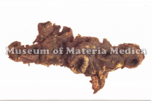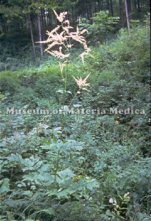Cimicifuga Rhizome

|
Market name:升麻 Photo location:Museum of Materia Medica, Inst. of Nat. Med. TMPW No.:1049 |

|
Plant name:Cimicifuga dahurica Photo location:Liaoning Prov., China Photo date:1992 Photographer:XBL |
| Synonym | |
| Latin name | Cimicifugae Rhizoma |
| Botanical source: Family name | Ranunculaceae |
| Botanical source: Plant name | - Cimicifuga dahurica Huth (IPNI:709429-1) - Cimicifuga heracleifolia Komarov (IPNI:709435-1) - Cimicifuga foetida Linné (IPNI:709433-1) - Cimicifuga simplex Wormskjold ex De Candolle (IPNI:709448-1) |
| Part used | Rhizome |
| Empirical criteria for quality selection | Good one is large without fine roots and the outer surface is black. The cross section is white or light green. (NI) |
| Constituents | Triterpenoids: Cimigenol 3-arabinoside, Cimigol, Isodahurinol, Acerionol, Cimicifugoside, 26-O-Methylcimifugoside, Cimifugenin A, 26-O-Methylcimifugenin A, Cimicifugenol, Acetylshengmanol xyloside, Friedelin; [C. dahurica]: Cimigenol, Cimigenol xyloside, Dahurinol; [C. acerina]: Cimigenol, Acerinol, 25-O-Acetylcimigenol, 25-O-Methylcimigenol, Dehydroxy-15-O-methylcimigenol, 15-O-Methylcimigenol, 25-O-Acetylcimigenoside, 25-O-Methylcimigenoside; [C. foetida]: Cimicidanol, Foetidinol, Acetylacteol-3-O-arabinoside, 25-Anhydrocimigenol-3-O-β-xyloside, Cimicidanol-3-O-β-xyloside, Cimicidol-3-O-β-xyloside, Cimicifol, Cimicinol, Foetidinol-3-O-β-xyloside, 15-α-Hydroxycimicidol-3-O-β-xyloside, 15-α-Hydroxyfoetidinol-3-O-β-xyloside [C. heracleifolia]: 24-epi-Acerinol, 25-O-Acetyl-7,8-didehydrocimigenol, 7,8-Didehydrocimigenol, 24-epi-7,8-Didehydrocimigenol, Heracleifolinol 3-keto-24-epi-7,8-didehydrocimigenol, 3'-O-Acetyl-24-epi-7,8-didehydrocimigenol-3-O-β-xyloside, 2',4'-Di-O-acetyl-24-epi-7,8-didehydrocimigenol-3-O-β-xyloside, 7,8-Didehydro-24-O-acetylhydroshengmanol-3-O-β-xyloside, 24-epi-7,8-Didehydrocimigenol-3-O-β-xyloside Sterols: [C. dahurica]: β-Sitosterol; [C. acerina]: β-Sitosterol Phenylpropanoids: [C. dahurica]: Ferulic acid, Isoferulic acid Chromones: Visamminol; [C. dahurica]: Visnagin; [C. simplex]: Khellol, Ammiol, Cimifugin |
| Pharmacological effects | Antifebrile, analgesic, antiinflammatory, sedative, antihypertensive, inhibitior of bone resorption. |
| Indications | As an antifebrile, antidote, and anti inflammatory drug, it is used to treat fever, headache, pharyngitis, cold, measles, and anal prolapse. |
| Diseases | Urticaria, Anal fistula, Pruritus, Hematochezia due to proctoptosis, Descent of the uterus, Measles, Erosion of the root of tooth, Bad breath, Stomatitis, Swelling and pain of the throat, Headache, Chronic diarrhea |
| Formulas | otsujito , otsujitokyodaio , kamigedokuto , shikonboreito , shomakakkonto , shin'iseihaito , jingyokyokatsuto , jingyobofuto , seinetsuhokito , hochuekkito , rikkosan , reitakutsukito , reitakutsukitokashin'i |
| Meridian tropism | Lung, Spleen, Large intestine, Stomach |
| Property | Slightly cold |
| Flavor | Sweet, Acrid/pungent |
| Classification in "Shen-non Ben-cao Jing" | Superior |
| TCM: Classification | Diaphoretics |
| TCM: Medicinal effects | To relieve exterior syndrome, clear away toxic material and let out skin eruption, lift up yang-energy. Used for common cold of wind-heat type, dental pain, aphthae, pharyngitis, laryngitis, measles with indistinct eruption, anal prolapse, uterine prolapse. |
| Remarks | Listed in the Japanese Pharmacopoeia 18th ed. |
| References | NI: N. Isshiki, Methods of Quality Evaluation and Preparation of Wakan-yaku [Wakanyaku no ryohi kanbetsu-ho oyobi chosei-ho], Tohodo Shoten, Tokyo, 1987. |
DNA sequences of medicinal plants
